belt MAZDA MODEL 3 HATCHBACK 2009 (in English) User Guide
[x] Cancel search | Manufacturer: MAZDA, Model Year: 2009, Model line: MODEL 3 HATCHBACK, Model: MAZDA MODEL 3 HATCHBACK 2009Pages: 412, PDF Size: 4.87 MB
Page 23 of 412
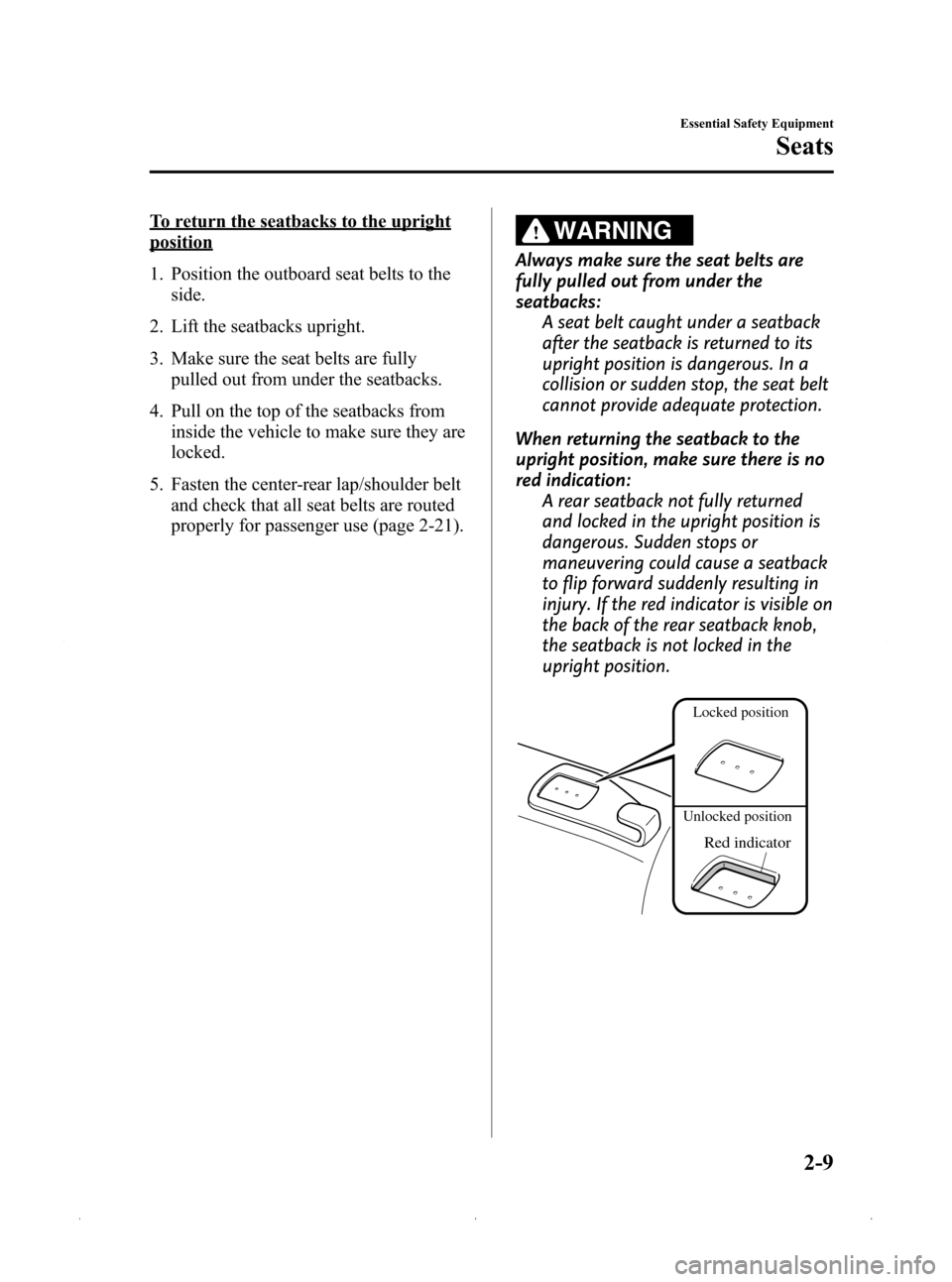
Black plate (23,1)
To return the seatbacks to the upright
position
1. Position the outboard seat belts to theside.
2. Lift the seatbacks upright.
3. Make sure the seat belts are fully pulled out from under the seatbacks.
4. Pull on the top of the seatbacks from inside the vehicle to make sure they are
locked.
5. Fasten the center-rear lap/shoulder belt and check that all seat belts are routed
properly for passenger use (page 2-21).WARNING
Always make sure the seat belts are
fully pulled out from under the
seatbacks: A seat belt caught under a seatback
after the seatback is returned to its
upright position is dangerous. In a
collision or sudden stop, the seat belt
cannot provide adequate protection.
When returning the seatback to the
upright position, make sure there is no
red indication: A rear seatback not fully returned
and locked in the upright position is
dangerous. Sudden stops or
maneuvering could cause a seatback
to flip forward suddenly resulting in
injury. If the red indicator is visible on
the back of the rear seatback knob,
the seatback is not locked in the
upright position.
Locked position
Unlocked position
Red indicator
Essential Safety Equipment
Seats
2-9
Mazda3_8Z87-EA-08F_Edition1 Page23
Monday, May 19 2008 9:55 AM
Form No.8Z87-EA-08F
Page 27 of 412
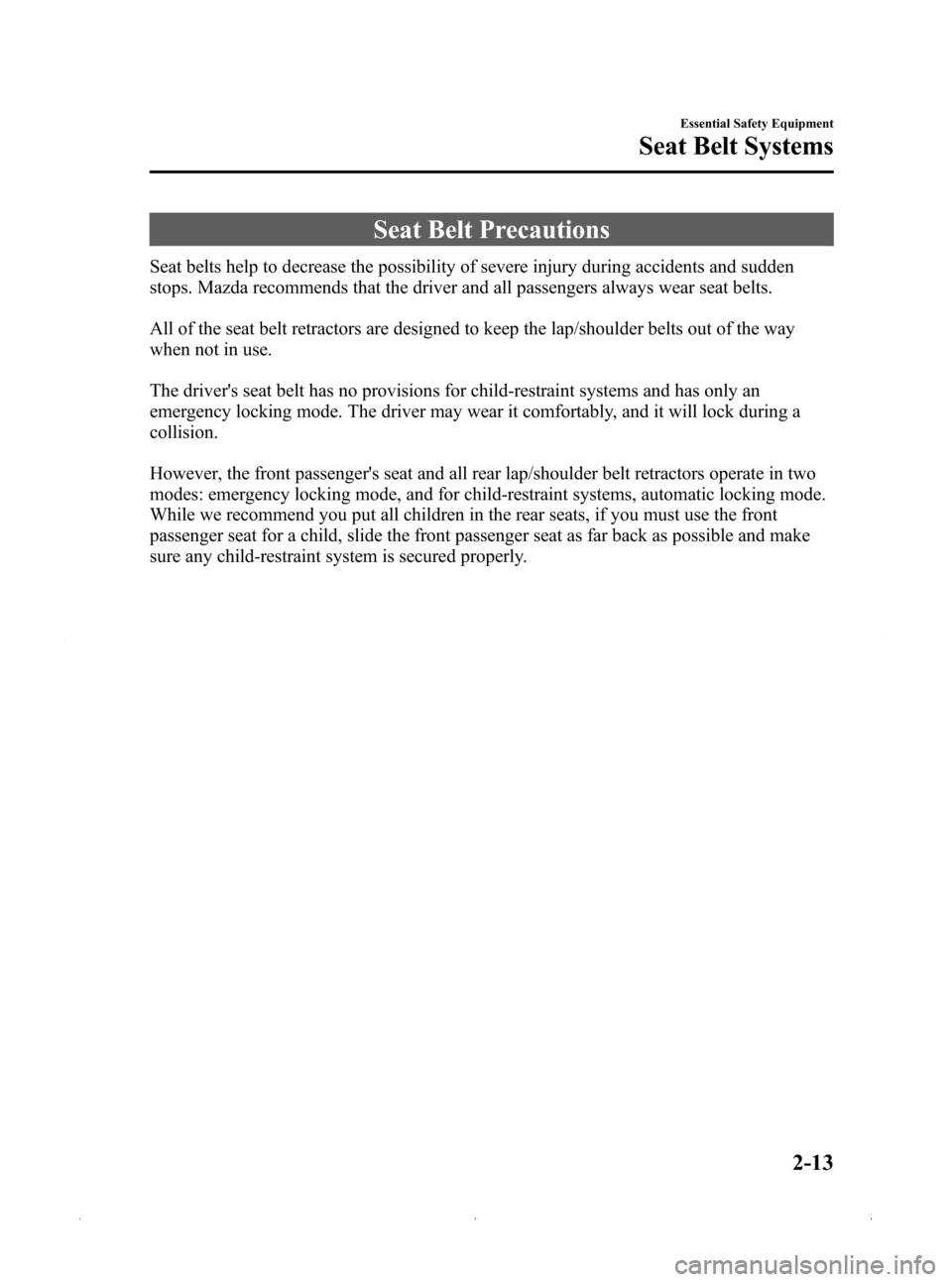
Black plate (27,1)
Seat Belt Precautions
Seat belts help to decrease the possibility of severe injury during accidents and sudden
stops. Mazda recommends that the driver and all passengers always wear seat belts.
All of the seat belt retractors are designed to keep the lap/shoulder belts out of the way
when not in use.
The driver's seat belt has no provisions for child-restraint systems and has only an
emergency locking mode. The driver may wear it comfortably, and it will lock during a
collision.
However, the front passenger's seat and all rear lap/shoulder belt retractors operate in two
modes: emergency locking mode, and for child-restraint systems, automatic locking mode.
While we recommend you put all children in the rear seats, if you must use the front
passenger seat for a child, slide the front passenger seat as far back as possible and make
sure any child-restraint system is secured properly.
Essential Safety Equipment
Seat Belt Systems
2-13
Mazda3_8Z87-EA-08F_Edition1 Page27
Monday, May 19 2008 9:55 AM
Form No.8Z87-EA-08F
Page 28 of 412
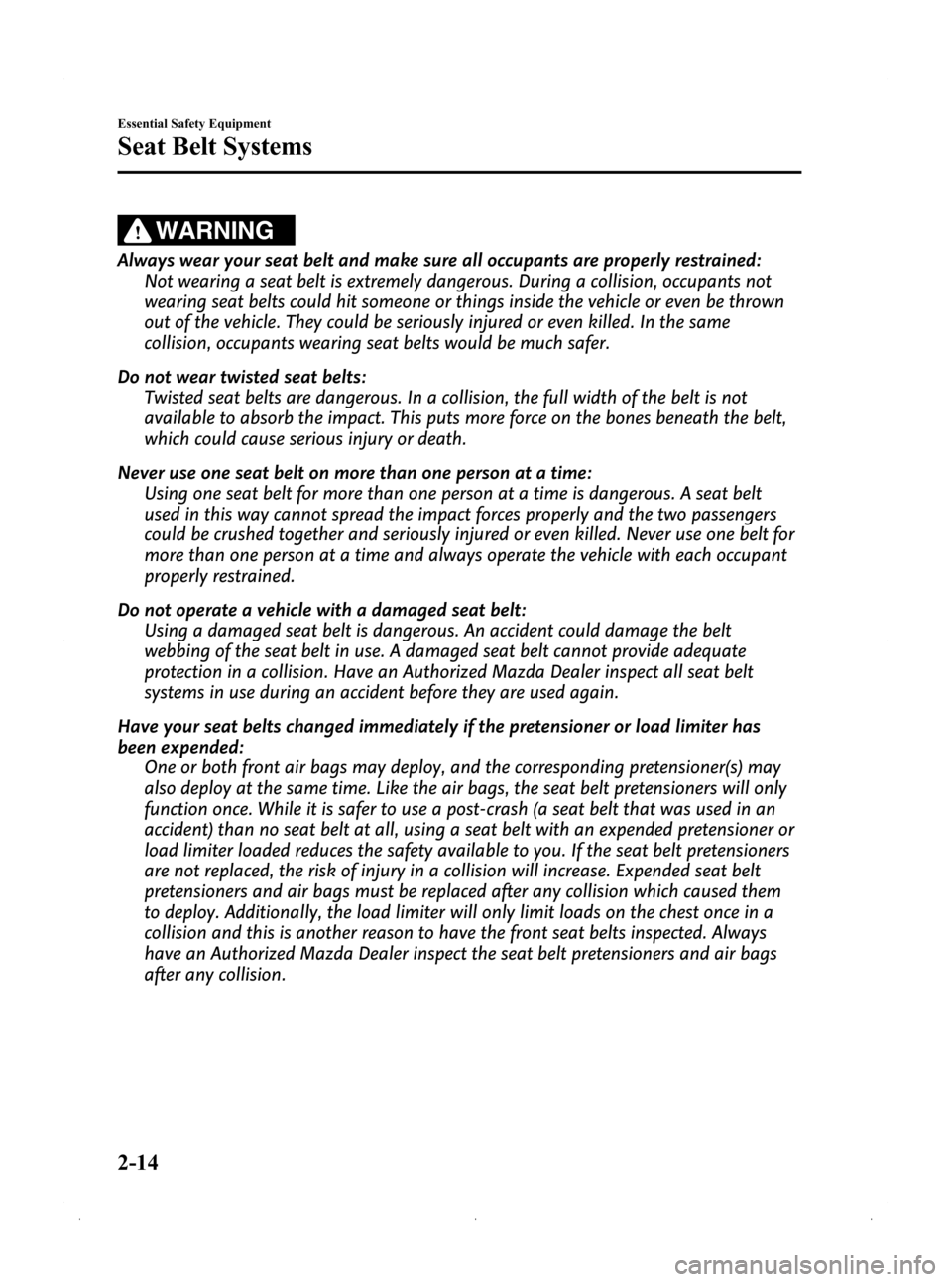
Black plate (28,1)
WARNING
Always wear your seat belt and make sure all occupants are properly restrained:Not wearing a seat belt is extremely dangerous. During a collision, occupants not
wearing seat belts could hit someone or things inside the vehicle or even be thrown
out of the vehicle. They could be seriously injured or even killed. In the same
collision, occupants wearing seat belts would be much safer.
Do not wear twisted seat belts: Twisted seat belts are dangerous. In a collision, the full width of the belt is not
available to absorb the impact. This puts more force on the bones beneath the belt,
which could cause serious injury or death.
Never use one seat belt on more than one person at a time: Using one seat belt for more than one person at a time is dangerous. A seat belt
used in this way cannot spread the impact forces properly and the two passengers
could be crushed together and seriously injured or even killed. Never use one belt for
more than one person at a time and always operate the vehicle with each occupant
properly restrained.
Do not operate a vehicle with a damaged seat belt: Using a damaged seat belt is dangerous. An accident could damage the belt
webbing of the seat belt in use. A damaged seat belt cannot provide adequate
protection in a collision. Have an Authorized Mazda Dealer inspect all seat belt
systems in use during an accident before they are used again.
Have your seat belts changed immediately if the pretensioner or load limiter has
been expended: One or both front air bags may deploy, and the corresponding pretensioner(s) may
also deploy at the same time. Like the air bags, the seat belt pretensioners will only
function once. While it is safer to use a post-crash (a seat belt that was used in an
accident) than no seat belt at all, using a seat belt with an expended pretensioner or
load limiter loaded reduces the safety available to you. If the seat belt pretensioners
are not replaced, the risk of injury in a collision will increase. Expended seat belt
pretensioners and air bags must be replaced after any collision which caused them
to deploy. Additionally, the load limiter will only limit loads on the chest once in a
collision and this is another reason to have the front seat belts inspected. Always
have an Authorized Mazda Dealer inspect the seat belt pretensioners and air bags
after any collision.
2-14
Essential Safety Equipment
Seat Belt Systems
Mazda3_8Z87-EA-08F_Edition1 Page28
Monday, May 19 2008 9:55 AM
Form No.8Z87-EA-08F
Page 29 of 412
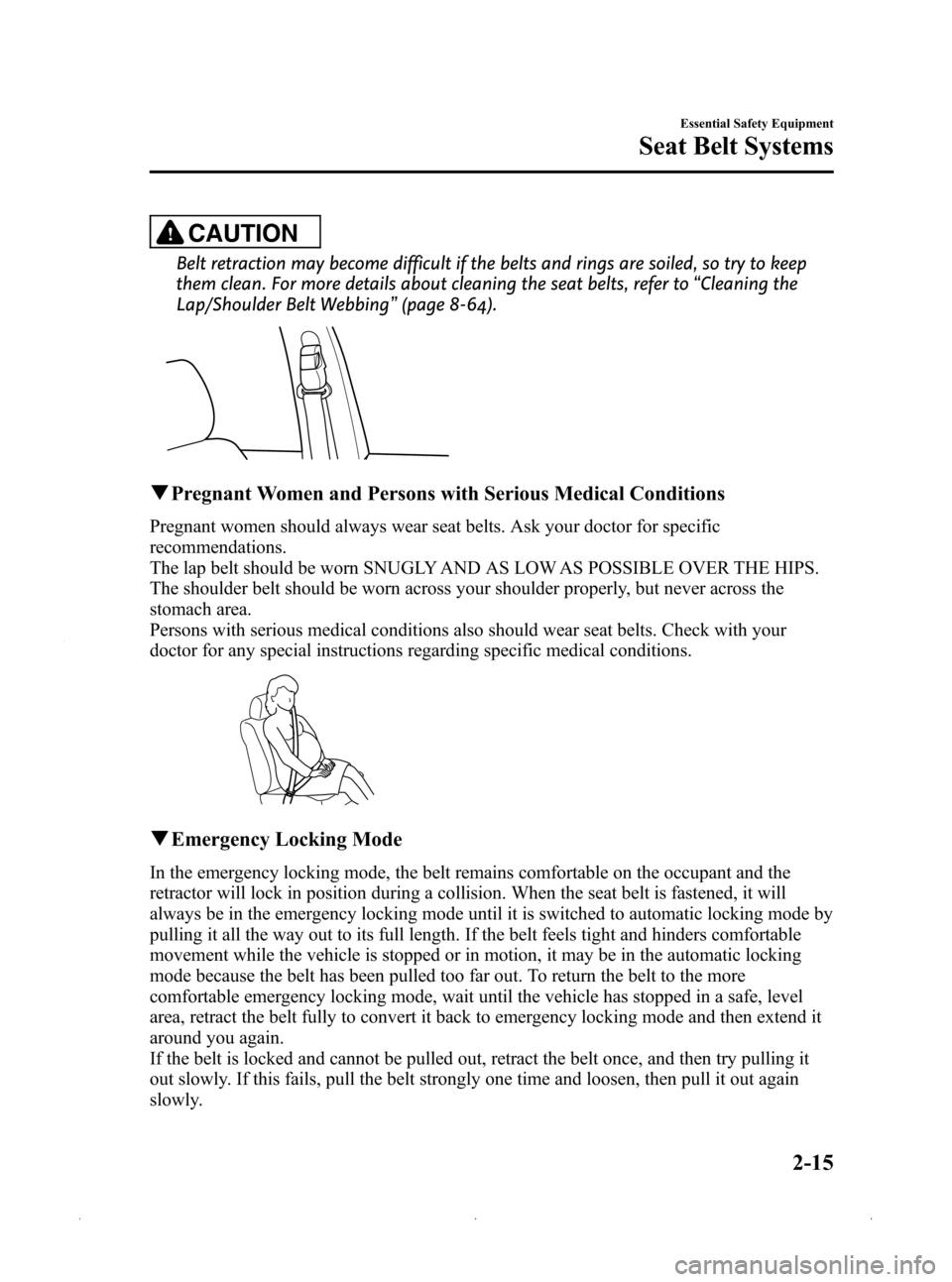
Black plate (29,1)
CAUTION
Belt retraction may become difficult if the belts and rings are soiled, so try to keep
them clean. For more details about cleaning the seat belts, refer to“Cleaning the
Lap/Shoulder Belt Webbing ”(page 8-64).
q Pregnant Women and Persons with Serious Medical Conditions
Pregnant women should always wear seat belts. Ask your doctor for specific
recommendations.
The lap belt should be worn SNUGLY AND AS LOW AS POSSIBLE OVER THE HIPS.
The shoulder belt should be worn across your shoulder properly, but never across the
stomach area.
Persons with serious medical conditions also should wear seat belts. Check with your
doctor for any special instructions regarding specific medical conditions.
qEmergency Locking Mode
In the emergency locking mode, the belt remains comfortable on the occupant and the
retractor will lock in position during a collision. When the seat belt is fastened, it will
always be in the emergency locking mode until it is switched to automatic locking mode by
pulling it all the way out to its full length. If the belt feels tight and hinders comfortable
movement while the vehicle is stopped or in motion, it may be in the automatic locking
mode because the belt has been pulled too far out. To return the belt to the more
comfortable emergency locking mode, wait until the vehicle has stopped in a safe, level
area, retract the belt fully to convert it back to emergency locking mode and then extend it
around you again.
If the belt is locked and cannot be pulled out, retract the belt once, and then try pulling it
out slowly. If this fails, pull the belt strongly one time and loosen, then pull it out again
slowly.
Essential Safety Equipment
Seat Belt Systems
2-15
Mazda3_8Z87-EA-08F_Edition1 Page29
Monday, May 19 2008 9:55 AM
Form No.8Z87-EA-08F
Page 30 of 412
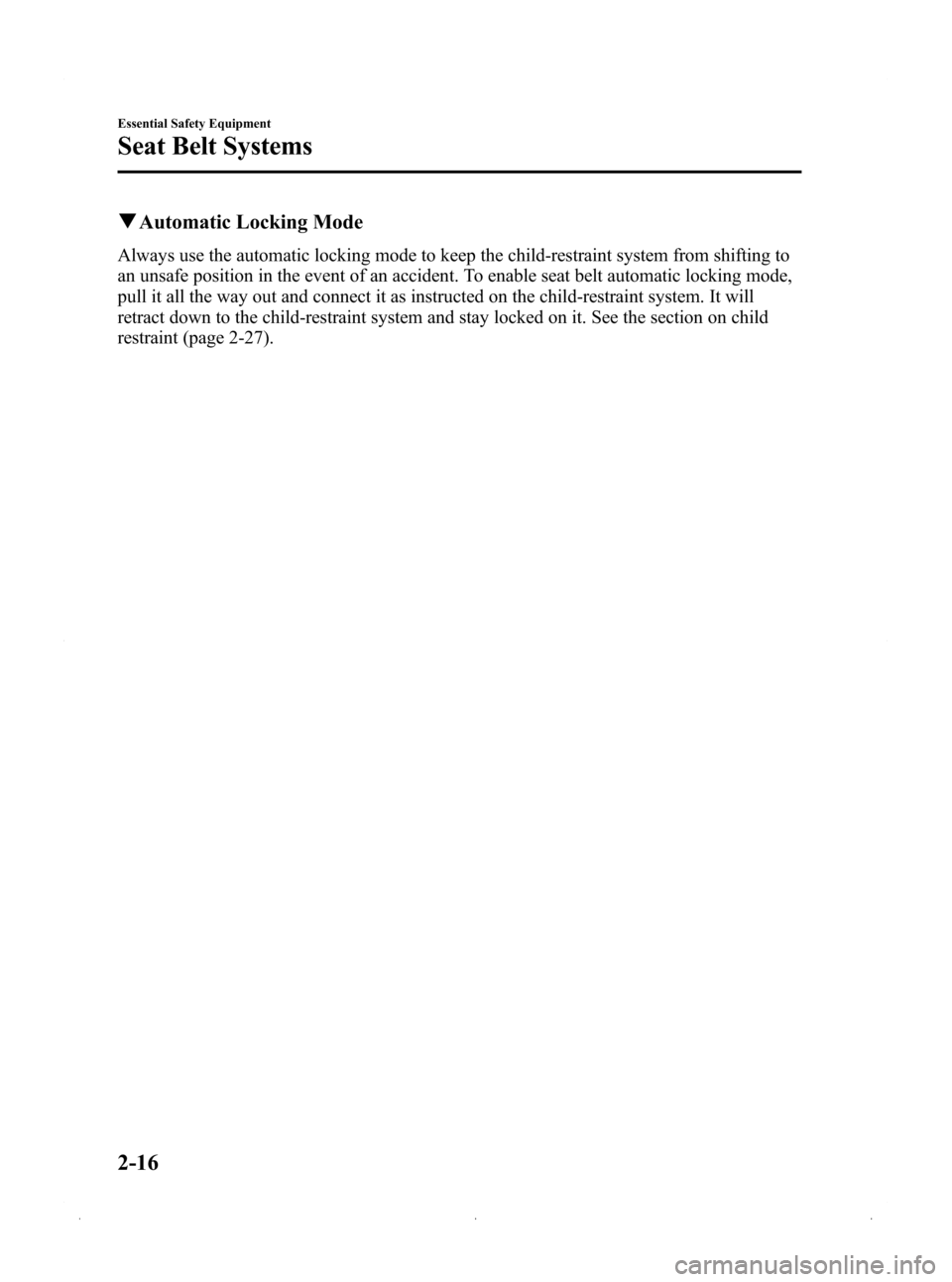
Black plate (30,1)
qAutomatic Locking Mode
Always use the automatic locking mode to keep the child-restraint system from shifting to
an unsafe position in the event of an accident. To enable seat belt automatic locking mode,
pull it all the way out and connect it as instructed on the child-restraint system. It will
retract down to the child-restraint system and stay locked on it. See the section on child
restraint (page 2-27).
2-16
Essential Safety Equipment
Seat Belt Systems
Mazda3_8Z87-EA-08F_Edition1 Page30
Monday, May 19 2008 9:55 AM
Form No.8Z87-EA-08F
Page 31 of 412
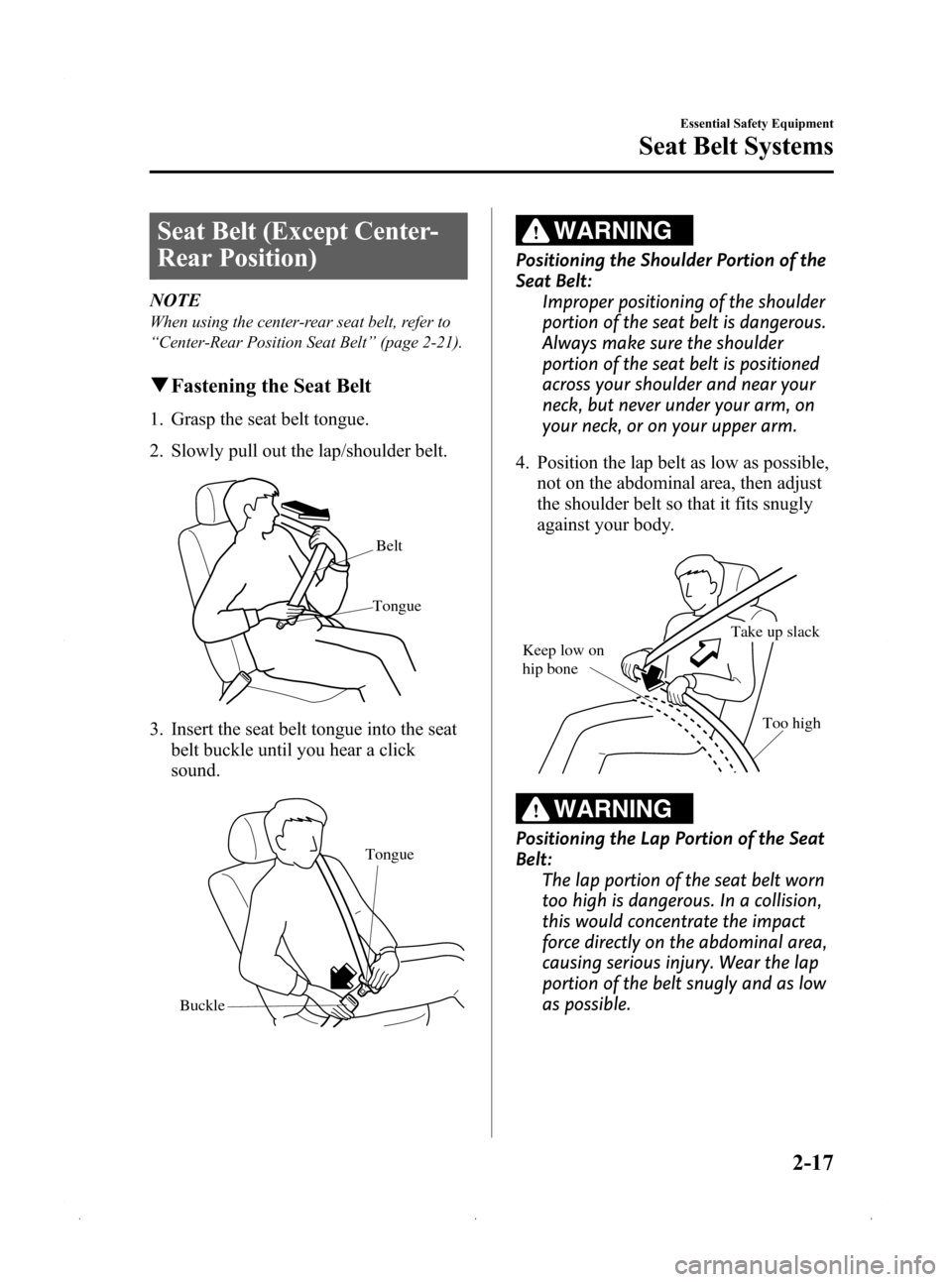
Black plate (31,1)
Seat Belt (Except Center-
Rear Position)
NOTE
When using the center-rear seat belt, refer to
“Center-Rear Position Seat Belt” (page 2-21).
qFastening the Seat Belt
1. Grasp the seat belt tongue.
2. Slowly pull out the lap/shoulder belt.
TongueBelt
3. Insert the seat belt tongue into the seat
belt buckle until you hear a click
sound.
Buckle Tongue
WARNING
Positioning the Shoulder Portion of the
Seat Belt:
Improper positioning of the shoulder
portion of the seat belt is dangerous.
Always make sure the shoulder
portion of the seat belt is positioned
across your shoulder and near your
neck, but never under your arm, on
your neck, or on your upper arm.
4. Position the lap belt as low as possible, not on the abdominal area, then adjust
the shoulder belt so that it fits snugly
against your body.
Keep low on
hip bone
Too high
Take up slack
WARNING
Positioning the Lap Portion of the Seat
Belt:
The lap portion of the seat belt worn
too high is dangerous. In a collision,
this would concentrate the impact
force directly on the abdominal area,
causing serious injury. Wear the lap
portion of the belt snugly and as low
as possible.
Essential Safety Equipment
Seat Belt Systems
2-17
Mazda3_8Z87-EA-08F_Edition1 Page31
Monday, May 19 2008 9:55 AM
Form No.8Z87-EA-08F
Page 32 of 412
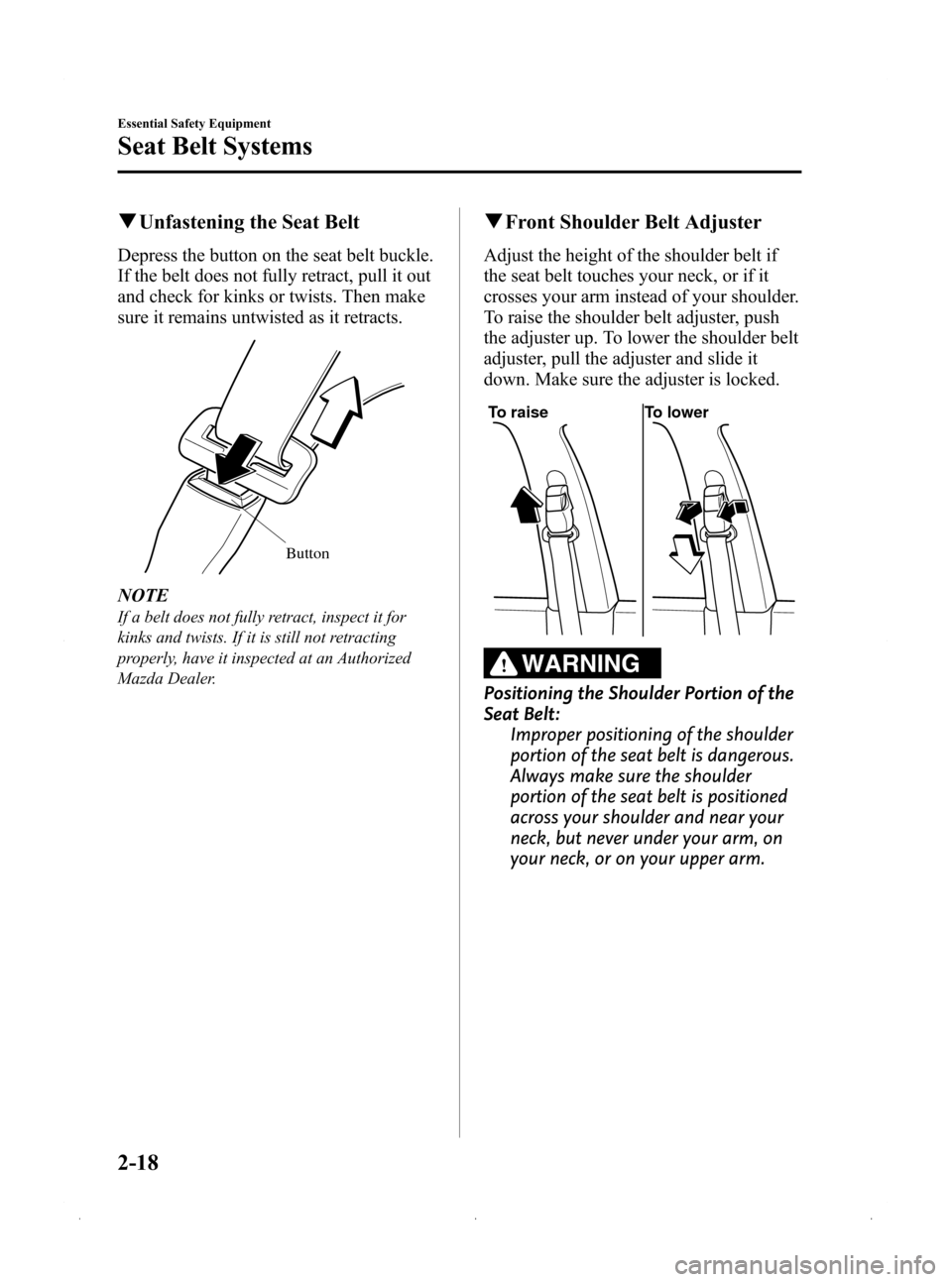
Black plate (32,1)
qUnfastening the Seat Belt
Depress the button on the seat belt buckle.
If the belt does not fully retract, pull it out
and check for kinks or twists. Then make
sure it remains untwisted as it retracts.
Button
NOTE
If a belt does not fully retract, inspect it for
kinks and twists. If it is still not retracting
properly, have it inspected at an Authorized
Mazda Dealer.
qFront Shoulder Belt Adjuster
Adjust the height of the shoulder belt if
the seat belt touches your neck, or if it
crosses your arm instead of your shoulder.
To raise the shoulder belt adjuster, push
the adjuster up. To lower the shoulder belt
adjuster, pull the adjuster and slide it
down. Make sure the adjuster is locked.
To raise To lower
WARNING
Positioning the Shoulder Portion of the
Seat Belt:
Improper positioning of the shoulder
portion of the seat belt is dangerous.
Always make sure the shoulder
portion of the seat belt is positioned
across your shoulder and near your
neck, but never under your arm, on
your neck, or on your upper arm.
2-18
Essential Safety Equipment
Seat Belt Systems
Mazda3_8Z87-EA-08F_Edition1 Page32
Monday, May 19 2008 9:55 AM
Form No.8Z87-EA-08F
Page 33 of 412
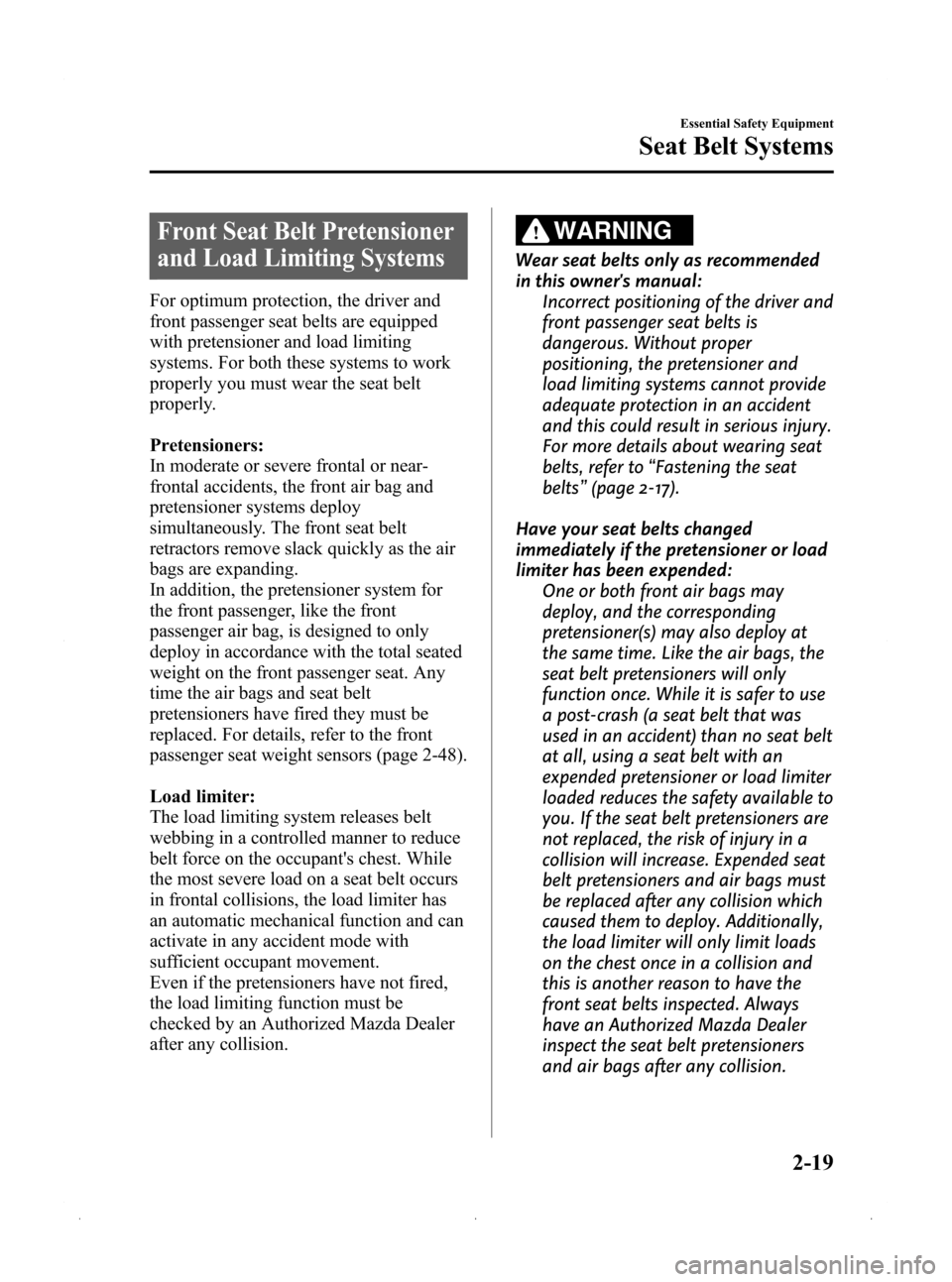
Black plate (33,1)
Front Seat Belt Pretensioner
and Load Limiting Systems
For optimum protection, the driver and
front passenger seat belts are equipped
with pretensioner and load limiting
systems. For both these systems to work
properly you must wear the seat belt
properly.
Pretensioners:
In moderate or severe frontal or near-
frontal accidents, the front air bag and
pretensioner systems deploy
simultaneously. The front seat belt
retractors remove slack quickly as the air
bags are expanding.
In addition, the pretensioner system for
the front passenger, like the front
passenger air bag, is designed to only
deploy in accordance with the total seated
weight on the front passenger seat. Any
time the air bags and seat belt
pretensioners have fired they must be
replaced. For details, refer to the front
passenger seat weight sensors (page 2-48).
Load limiter:
The load limiting system releases belt
webbing in a controlled manner to reduce
belt force on the occupant's chest. While
the most severe load on a seat belt occurs
in frontal collisions, the load limiter has
an automatic mechanical function and can
activate in any accident mode with
sufficient occupant movement.
Even if the pretensioners have not fired,
the load limiting function must be
checked by an Authorized Mazda Dealer
after any collision.
WARNING
Wear seat belts only as recommended
in this owner's manual:Incorrect positioning of the driver and
front passenger seat belts is
dangerous. Without proper
positioning, the pretensioner and
load limiting systems cannot provide
adequate protection in an accident
and this could result in serious injury.
For more details about wearing seat
belts, refer to “Fastening the seat
belts ”(page 2-17).
Have your seat belts changed
immediately if the pretensioner or load
limiter has been expended: One or both front air bags may
deploy, and the corresponding
pretensioner(s) may also deploy at
the same time. Like the air bags, the
seat belt pretensioners will only
function once. While it is safer to use
a post-crash (a seat belt that was
used in an accident) than no seat belt
at all, using a seat belt with an
expended pretensioner or load limiter
loaded reduces the safety available to
you. If the seat belt pretensioners are
not replaced, the risk of injury in a
collision will increase. Expended seat
belt pretensioners and air bags must
be replaced after any collision which
caused them to deploy. Additionally,
the load limiter will only limit loads
on the chest once in a collision and
this is another reason to have the
front seat belts inspected. Always
have an Authorized Mazda Dealer
inspect the seat belt pretensioners
and air bags after any collision.
Essential Safety Equipment
Seat Belt Systems
2-19
Mazda3_8Z87-EA-08F_Edition1 Page33
Monday, May 19 2008 9:55 AM
Form No.8Z87-EA-08F
Page 34 of 412
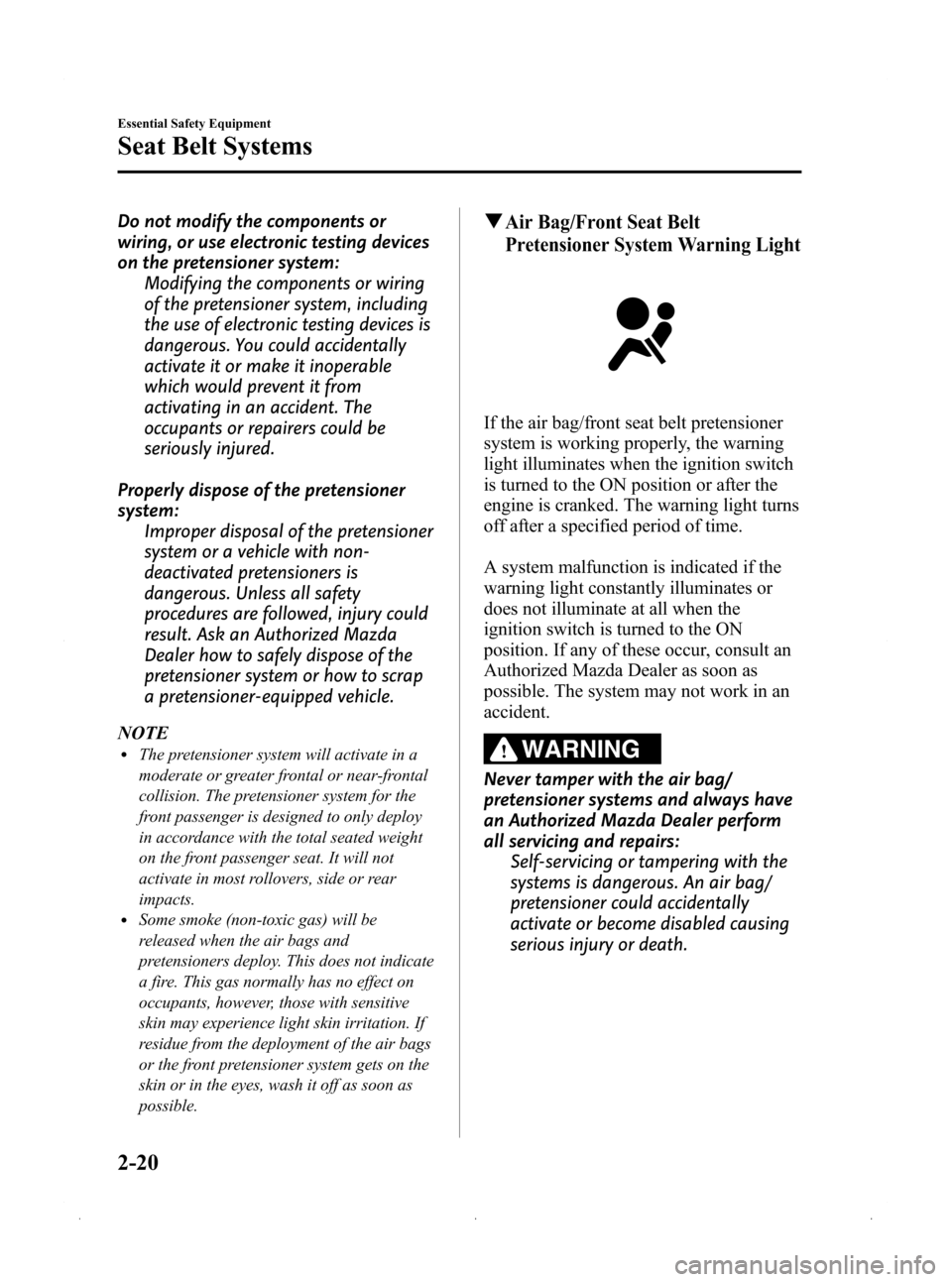
Black plate (34,1)
Do not modify the components or
wiring, or use electronic testing devices
on the pretensioner system:Modifying the components or wiring
of the pretensioner system, including
the use of electronic testing devices is
dangerous. You could accidentally
activate it or make it inoperable
which would prevent it from
activating in an accident. The
occupants or repairers could be
seriously injured.
Properly dispose of the pretensioner
system: Improper disposal of the pretensioner
system or a vehicle with non-
deactivated pretensioners is
dangerous. Unless all safety
procedures are followed, injury could
result. Ask an Authorized Mazda
Dealer how to safely dispose of the
pretensioner system or how to scrap
a pretensioner-equipped vehicle.
NOTE
lThe pretensioner system will activate in a
moderate or greater frontal or near-frontal
collision. The pretensioner system for the
front passenger is designed to only deploy
in accordance with the total seated weight
on the front passenger seat. It will not
activate in most rollovers, side or rear
impacts.
lSome smoke (non-toxic gas) will be
released when the air bags and
pretensioners deploy. This does not indicate
a fire. This gas normally has no effect on
occupants, however, those with sensitive
skin may experience light skin irritation. If
residue from the deployment of the air bags
or the front pretensioner system gets on the
skin or in the eyes, wash it off as soon as
possible.
qAir Bag/Front Seat Belt
Pretensioner System Warning Light
If the air bag/front seat belt pretensioner
system is working properly, the warning
light illuminates when the ignition switch
is turned to the ON position or after the
engine is cranked. The warning light turns
off after a specified period of time.
A system malfunction is indicated if the
warning light constantly illuminates or
does not illuminate at all when the
ignition switch is turned to the ON
position. If any of these occur, consult an
Authorized Mazda Dealer as soon as
possible. The system may not work in an
accident.
WARNING
Never tamper with the air bag/
pretensioner systems and always have
an Authorized Mazda Dealer perform
all servicing and repairs: Self-servicing or tampering with the
systems is dangerous. An air bag/
pretensioner could accidentally
activate or become disabled causing
serious injury or death.
2-20
Essential Safety Equipment
Seat Belt Systems
Mazda3_8Z87-EA-08F_Edition1 Page34
Monday, May 19 2008 9:55 AM
Form No.8Z87-EA-08F
Page 35 of 412
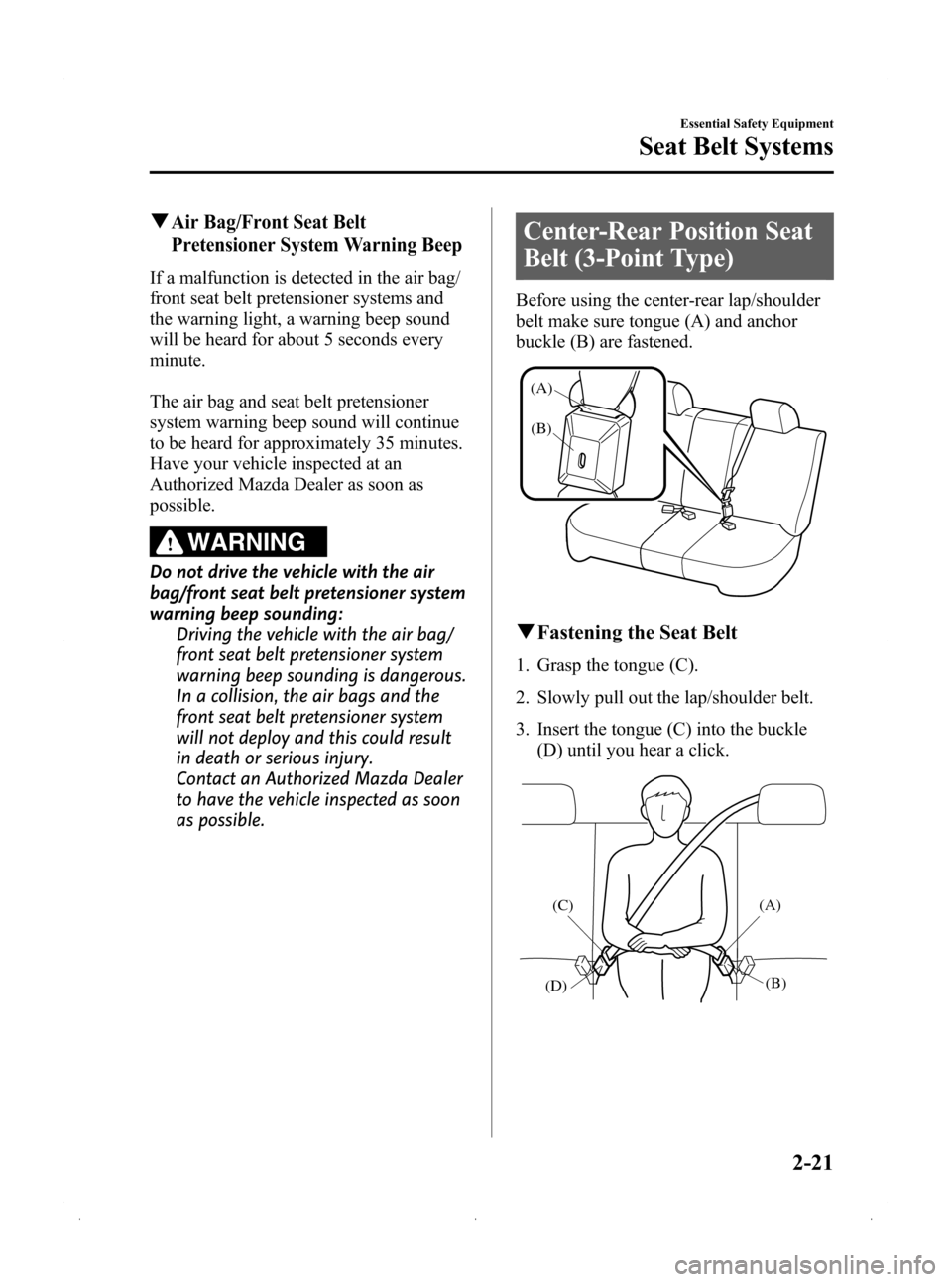
Black plate (35,1)
qAir Bag/Front Seat Belt
Pretensioner System Warning Beep
If a malfunction is detected in the air bag/
front seat belt pretensioner systems and
the warning light, a warning beep sound
will be heard for about 5 seconds every
minute.
The air bag and seat belt pretensioner
system warning beep sound will continue
to be heard for approximately 35 minutes.
Have your vehicle inspected at an
Authorized Mazda Dealer as soon as
possible.
WARNING
Do not drive the vehicle with the air
bag/front seat belt pretensioner system
warning beep sounding:Driving the vehicle with the air bag/
front seat belt pretensioner system
warning beep sounding is dangerous.
In a collision, the air bags and the
front seat belt pretensioner system
will not deploy and this could result
in death or serious injury.
Contact an Authorized Mazda Dealer
to have the vehicle inspected as soon
as possible.
Center-Rear Position Seat
Belt (3-Point Type)
Before using the center-rear lap/shoulder
belt make sure tongue (A) and anchor
buckle (B) are fastened.
(A)
(B)
qFastening the Seat Belt
1. Grasp the tongue (C).
2. Slowly pull out the lap/shoulder belt.
3. Insert the tongue (C) into the buckle
(D) until you hear a click.
(C)
(D) (B)
(A)
Essential Safety Equipment
Seat Belt Systems
2-21
Mazda3_8Z87-EA-08F_Edition1 Page35
Monday, May 19 2008 9:55 AM
Form No.8Z87-EA-08F